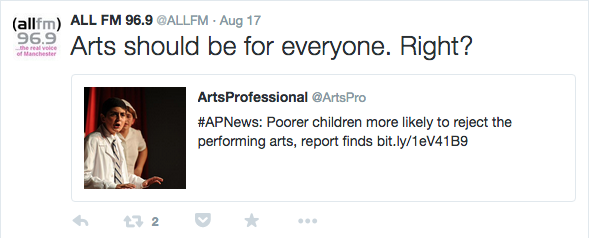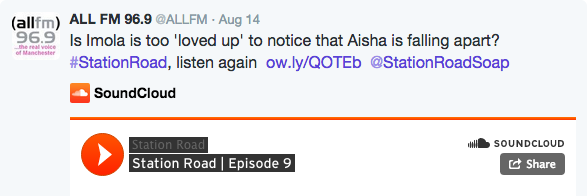Developing a social media strategy
Everything you do on social media should, ideally, be underpinned by a set of goals/aims and a social media strategy or action plan. Having a strategic plan will help you to address:
- what your organisation wants to achieve through social media
- which social media sites to focus on
- how to engage your audience
- how frequently to post
- how to measure your social media impact
- what to do if things go wrong, or when you’re criticised
A social media strategy or action plan may exist as a document, or it may be more a set of understood principles shared by your Social Media team, or it may take the form of a calendar in which you try out different approaches at different times so that you can evaluate what works best for you.
It might seem that a having a social media action plan is overkill; that the only organisations that have one are well-resourced, commercial corporations. But, as this article points out, ‘the good guys need a plan too’.
5 key questions for developing a social media strategy:
- What do you want to achieve through social media?
- What time can you commit to social media?
- Who are your social media audience?
- Which social media sites are most likely to help you achieve what you want?
- Who will be involved in the delivery of your action plan?
- What do you want to achieve through social media?
This is the most important of all questions, because without a clear sense of purpose and priorities, your activity risks becoming aimless. You also need to have a workable number of aims, focusing on ONE or TWO things, not seven! The following are a few example aims:
- Increase online listenership
- Build an online following
- Sell station merchandise
- Increase volunteer numbers
- Make station more visible to partners and/or funders
- Raise awareness of station within local business sector
- Make links with specific groups within the community
- What time can you commit to social media?
- How much time do you have for social media? It might be worth setting an upper limit here. It’s very important to be realistic about what capacity you have to do this – this may then shape the way you intend to meet your goals.
- How frequently to post? Something to consider is social media fatigue: the fact that people can get tired of hearing the same messages over and over again. It’s also worth considering the risk of being perceived as spam (e.g. posting too frequently, or pushing one show/presenter at the expense of others), or ‘tumbleweed’ (posting very infrequently, making you less visible, and perhaps leaving doubt in your followers’ minds about what you’re doing).
- How much time does each site need to help meet your aims using that site?
- Do you need to reconsider which sites you are using to make most effective use of your time? A frequent piece of advice is to only do what you have the means to do well. It’s better to focus on one or two social media sites, rather than have ten infrequently updated sites. If you’re not sure, ask your audience through more traditional means – email, volunteers, etc.
- Who are your social media audience?
Your social media audience is not necessarily the same as your radio audience, but also includes people and organisations you work with, or are connected to, or want to engage with or impress (e.g. potential partners, funders).
Part of answering this question is thinking about the important messages you want to get across. See the example tweets below from ALLFM (Manchester) showing a cross-section of the work they do and the people and organisations they are involved with – including commentary on the role of the arts in society, producing a soap opera on ALLFM, and promoting local musicians.
- Which social media sites are most likely to help you achieve what you want?
Each social media site has its own demographics – just as your station does. Posting on Facebook is likely to engage a different group of people than using Twitter – though there may be overlaps. Facebook has the biggest population of users; though it may not reach as many of the kinds of people you want to reach as other sites. So it’s worth thinking about which site is likely to have the most payoff for your station (or doing analytics/research to find out).
You can also use different social media sites to complement each other – e.g. posting an image to Pinterest or Flickr, and then sharing that at a different time of day to Facebook/Twitter etc, with commentary appropriate to your strategy for that platform. This means that you’re using the same piece of content to engage with multiple audiences, and managing your engagement strategically to make best use of each platform.
- Who will be involved in the delivery of your action plan?
Each organisation needs to decide who has access to its social media accounts. In a community radio station, where the likelihood is that there aren’t resources to have a dedicated staff member for social media, the responsibility for posting on behalf of the station needs to be taken by one or more people. Sometimes this is the station manager alone; sometimes it is a specific volunteer; sometimes it is made open to a large number of, or even all, volunteers. Each of these possibilities has implications that need consideration and planning – for example, if all volunteers can post, how to ensure consistency of output; or if left to one member of staff, what happens when they have a day off or are sick?
See the video below with thoughts from Mary Dowson, station manager at BCB (Bradford), on making sure that social media is embedded into the station’s weekly planning, and that there is always someone who will be able to manage social media.
Some more things to think about…
The following are a series of questions you may want to consider – with discussion about the implications of taking different approaches.
How is social media helping you achieve your mission? How could it better help you achieve your mission?
This is a fundamental question which should shape your social media use. Are you using social media for a purpose? How does using e.g. Twitter benefit the station?
What aspects of your work do you show on social media, and what are the implications of this?
Does your social media feed show all aspects of what you do as an organisation? Or, put another way, what would someone who doesn’t know anything about your organisation think you do if they were to look at your feed? Is this what you want?
What do you want your audience to do with your social media content and how are you going to encourage them to do that?
Do you want your followers to comment on your posts? Or share them? Or go to your website? Or donate to your organisation? What’s the best way of encouraging them to take these actions?
How will you manage the identity/voice of individuals and your station?
Does your station have one voice, or many voices? What tone of voice is best for you: serious, jokey, interactive, authoritative…? How will you manage ‘station voice’, and the potential tension between presenters’ voices and presenting an ‘image’ to partners. (Again, think of your audience, and what you want to achieve through social media.) Who is excluded, and what are the implications of this…?
This is often the biggest anxiety for stations, or the biggest challenge they have faced in adopting an open approach to social media: how to ensure that allowing, say, every volunteer to post to Twitter/Facebook will maintain the level of consistency that you want? (You may not want consistency, of course.) How can you allow your volunteers to really use, and take ownership of, your social media channels?
One way of approaching this is to have clear guidelines (or policy) for posting to social media, and to build this into the training of all volunteers so that they know what is expected of them, and what the consequences are of not following the guidelines (e.g. access to the tools are withdrawn).
Ultimately, the tensions between different possible approaches are something you will have to figure out in practice – according to what you want to achieve with social media. In the video below, Dan from BCB outlines how they as a station engaged their volunteers in producing a strategy – also involving doing a social media audit of their volunteers (see also next section).
Does your station document which of your presenters have social media profiles? Do you monitor these? Should you? Do you want to?
Do you know which of your presenters use what social media platforms? (Have you done an audit of your presenters?) Are presenters’ views affiliated with the station? As with the above question about ‘voice’, how are you going to manage station identity and volunteer diversity? Should the station intervene if, for example, a volunteer tweets about their show on the station followed by a tweet espousing racist or other offensive views? Do you have guidelines around this? Is this included in your training? See the video below of BCB, where they discuss their training for volunteers in using social media.
What are your listeners talking about / interested in?
Using social media to listen to your listeners could be a key way to:
- Identify topics that your listeners are already engaged with, and want to hear more about
- Allow listeners to feed into shows’ content
- Increase engagement and connection with listeners
Key actions:
- Identify what you want to achieve through social media
- Identify what sites are best placed to achieve your aims, and what types of output to focus on
- Make a timetable for your social media output for the next month (see below)
Create a weekly targeted action plan for engagement. This plan should ideally have SMART objectives (specific, measurable, attainable, relevant, time-bound). For example, one week’s plan might begin:
Monday
- Schedule 5 tweets: 2 about station content and 2 about local events/initiatives, 1 promoting Facebook page.
- Reply to any questions/queries that have arisen over the weekend. Retweet a maximum of 3 tweets.
- Follow 4 new local organisations.
- Schedule 1 post to Facebook about station with a photo.
- Connect with 2 new people on LinkedIn.
Tuesday
- Thank any new organisations who have connected with your station on Twitter.
- Schedule 4 tweets to go out during the day. Two about the station, one about training and one on a fact about your local area. The other should highlight a partnership your station currently has (be sure to “@ mention” them in the tweet).
- Post one update to Facebook promoting one of your station’s current initiatives.
- Like the pages of two local artists on Facebook.
Hootsuite have developed a useful guide to developing a social media content calendar.














